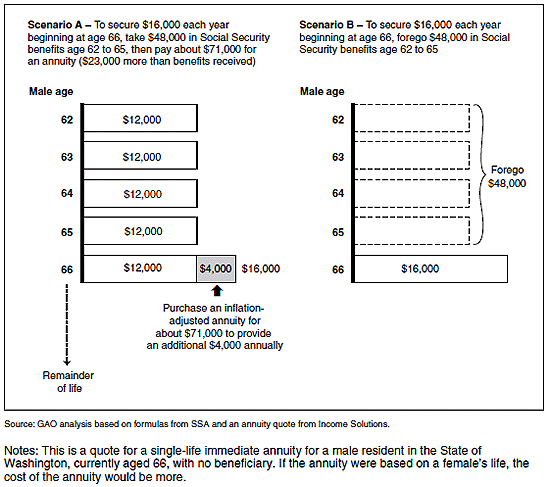Social Security is far more valuable than it used to be, and not just because of the 3.6% COLA announced last week. Scott Burns, in his October 2 column, "How Much are Social Security Benefits Really Worth?" asks how much cash you would need to generate the same amount of income that Social Security provides. It's a simple question of present value in the face of lower interest rates.
Back in 2000, when the yield on five-year Treasury obligations was 6.16%, you needed a lump sum of $162,843 to generate income equal to the average Social Security benefit of $840 per month. Today, with yields at 1.0%, you would need $1.4 million to get essentially the same income (the average benefit is now about $1,181).
The dramatic reduction in interest rates has not only lowered the discount rate that makes a future income stream more valuable, it has increased the relative importance of Social Security as a source of retirement income. The $100,000 IRA that would have earned $6,160 in 2000, now earns only $1,000 a year. Higher returns are available elsewhere, of course, but not without risk. The result is that for most people Social Security is likely to comprise a larger slice of the retirement income pie.
Many baby boomers are dealing with the unfortunate math caused by today's low interest rates by continuing to work. So for now, Social Security—for those who have started collecting—still represents a small slice of the retirement income pie. But at some point the earned income will stop. When that happens Social Security will step up to comprise a greater share of retirement income—40%, 50%, maybe even more. And that's when you will be thankful to offices like ours for helping maximize your benefits. By leading clients into decisions that improve their future income stream, my office is adding to your wealth just as if I had increased the value of your retirement and investment accounts.
Back in 2000, when the yield on five-year Treasury obligations was 6.16%, you needed a lump sum of $162,843 to generate income equal to the average Social Security benefit of $840 per month. Today, with yields at 1.0%, you would need $1.4 million to get essentially the same income (the average benefit is now about $1,181).
The dramatic reduction in interest rates has not only lowered the discount rate that makes a future income stream more valuable, it has increased the relative importance of Social Security as a source of retirement income. The $100,000 IRA that would have earned $6,160 in 2000, now earns only $1,000 a year. Higher returns are available elsewhere, of course, but not without risk. The result is that for most people Social Security is likely to comprise a larger slice of the retirement income pie.
Many baby boomers are dealing with the unfortunate math caused by today's low interest rates by continuing to work. So for now, Social Security—for those who have started collecting—still represents a small slice of the retirement income pie. But at some point the earned income will stop. When that happens Social Security will step up to comprise a greater share of retirement income—40%, 50%, maybe even more. And that's when you will be thankful to offices like ours for helping maximize your benefits. By leading clients into decisions that improve their future income stream, my office is adding to your wealth just as if I had increased the value of your retirement and investment accounts.
GAO says benefits from 62 to 66 wouldn't buy equivalent annuity
In their report, Retirement Income: Ensuring Income throughout Retirement Requires Difficult Choices, the Government Accountability Office says that the amount of money a retiree would receive by taking early benefits is less than the amount needed to purchase an annuity that would provide the additional income that would be available by waiting. As the graph below shows, an early claimer who receives $12,000 a year in benefits would receive an extra $48,000 from age 62 to 66. But he'd have to spend $71,000, or 47% more, to buy an annuity that would generate the $4,000 in additional income he would receive by applying for benefits at 66.
 |
***Keep in mind once again the above is dependent on the current interest rate and the outcome might change in a different interest rate environment.
